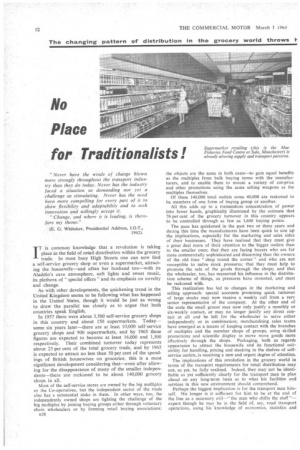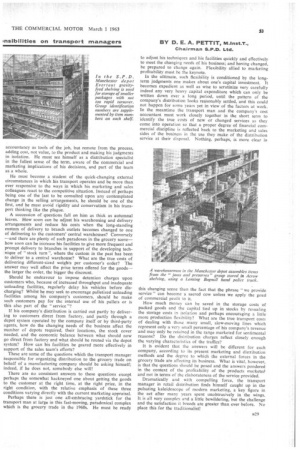No Place for Traditionalists!
Page 54

Page 55

If you've noticed an error in this article please click here to report it so we can fix it.
BY D. E. A. PETTIT, Minst.T., Chairman S.P.D. Ltd.
"Never have the winds of change blown more strongly throughout the transport industry than they do today. Never has the industry faced a situation so demanding nor yet a challenge so stimulating. Never has the need been more compelling for every part of it to show flexibility and adaptability and to seek innovation and willingly accept it.
"Change, and where it is leading, is therefore my theme."
(E. G. Whitaker, Presidential Address, 1.0.T, 1962).
IT is common knowledge that a revolution is taking place in the field of retail distribution within the grocery trade. In most busy High Streets one can now find a self-service grocery shop or even a supermarket, attracting the housewife—and often her husband too—with its Aladdin's cave atmosphere, soft lights and sweet music, its plethora of "special offers" and its emphasis on novelty and change.
As with other developments, the quickening trend in the United Kingdom seems to be following what has happened in the United States, though it would be just as wrong to draw the parallel too closely as to argue that both countries speak English.
In 1957 there were about 3,500 self-service grocery shops in this country and about 150 supermarkets. Today— some six years later—there are at least 10,000 self-service grocery shops and 900 supermarkets, and by 1965 these figures are expected to become at least 16,000 and 1,500 respectively. Their combined turnover today represents about 25 per cent of the total grocery trade, and by 1965 is expected to attract no less than 50 per cent of the spendings of British housewives on groceries; this is a most significant development considering that—even after allowing for the disappearance of many of the smaller independents—there are reckoned to be about 140,000 grocery shops in all.
Most of the self-service stores are owned by the big multiples or the Co-operatives, but the independent sector of the trade also has a substantial stake in them. In other ways, too, the independently owned shops are fighting the challenge of the big multiples by joining buying groups either through voluntary chain wholesalers or by forming retail buying associations: 828
the objects are the same in both cases—to gain equal benefits as the multiples from bulk buying terms with the manufacturers, and to enable them to mount a variety of cut-price and other promotions using the same selling weapons as the multiples themselves.
Of these 140,000 total outlets some 40,000 are reckoned to be members of one form of buying group or another.
All this adds up to a tremendous concentration of power into fewer hands, graphically illustrated by the estimate that 76 per cent of the grocery turnover in this country appears to be controlled through as few as 1,600 buying points.
The pace has quickened in the past two or three years and during this time the manufacturers have been quick to size up the implications, especially for the marketing and sales sides of their businesses. They have realized that they must give a great deal more of their attention to the bigger outlets than to the smaller ones; that they are facing buyers who are far more commercially sophisticated and discerning than the owners of the old time "shop round the corner" and who are not susceptible to naive stock pressures; that they must help to promote the sale of the goods through the shops; and that the wholesaler, too, has reasserted his influence in the distribution scheme of things, as pressures have mounted, and must be reckoned with.
This realization has led to changes in the marketing and selling approach: special accounts promising quick turnover of large stocks may now receive a weekly call from a very senior representative of the company. At the other end of the scale the small grocer may now only justify a monthly or six-weekly contact, or may no longer justify any direct contact at all and be left for the wholesaler to serve either independently or in combination; merchandising sales teams have emerged as a means of keeping contact with the branches of multiples and the member shops of groups, using skilled promotions and scientific display to move more goods more effectively through the shops. Packaging, both as regards appearance to attract the housewife and its functional suitability for handling, pricing and stacking in the shelves of selfservice outlets, is receiving a new and urgent degree of attention.
The implications of this revolution in the grocery world in terms of the transport requirements for retail distribution may not, as yet, be fully realized. Indeed, they may not be identifiable as yet sufficiently clearly for the transport man to plan ahead on any long-term basis as to what his facilities and services in this new environment should comprehend.
Perhaps the biggest implication is for the transport man himself. No longer is it sufficient for him to be at the end of the line as a necessary evil—" the man who shifts the stuff "expert though he may be in the field of, say, road transport operations, using his knowledge of economics, statistics and accountancy as tools of the job, but remote from the process, adding cost, not value, to the product and making his judgments in isolation. He must see himself as a distribution specialist in the fullest sense of the term, aware of the commercial and marketing implications of his decisions, and part of the team as a whole.
He must become a student of the quick-changing external circumstances in which his transport operates and be more than ever responsive to the ways in which his marketing and sales colleagues react to the competitive situation. Instead of perhaps being one of the last to be consulted upon any contemplated change in the selling arrangements, he should be one of the first, and he must avoid rigidity and conservatism in his transport thinking like the plague.
A succession of questions fall on him as thick as autumnal leaves. How soon can he adjust his warehousing and delivery arrangements and reduce his costs when the long-standing custom of delivery to branch outlets becomes changed to one of delivering to the customers' central warehouses? Conversely —and there are plenty of such paradoxes in the grocery scene— how soon can he increase his facilities to give more frequent and prompt delivery to branches in support of the developing technique of " stock turn ", where the custom in the past has been to deliver to a central warehouse? What are the true costs of delivering different-sized weights per customer's order? The answer may well affect the price terms offered for the goods— the larger the order, the bigger the discount.
Should he endeavour to impose detention charges upon customers who, because of increased throughput and inadequate unloading facilities, regularly delay his vehicles before discharging? Whilst he may seek to encourage palletized unloading facilities among his company's customers, should he make such customers pay for the internal use of his pallets or is this also part of the "service "?
If his company's distribution is carried out partly by delivering to customers direct from factory, and partly through a depot system operated by the company itself or by third-party agents, how do the changing needs of the business affect the number of depots required, their locations, the stock cover needed, and the economic balance between what should now go direct from factory and what should be routed via the depot system? How can his facilities be geared more effectively in support of the sales team's efforts?
These are some of the questions which the transport manager responsible for organizing distribution to the grocery trade on behalf of a manufacturing company should be asking himself; indeed, if he does not, somebody else will!
There are no consistent answers to these questions except perhaps the somewhat hackneyed one about getting the goods to the customer at the right time, at the right price, in the right condition, with the relative emphasis of these three conditions varying directly with the current marketing appraisal.
Perhaps there is just one all-embracing yardstick for the transport man at large in this fast-moving, paradoxical complex which is the grocery trade in the 1960s. He must be ready to adjust his techniques and his facilities quickly and effectively to meet the changing needs of his business; and having changed, be prepared to change again. Flexibility allied to marketing profitability must be the keynote.
In the ultimate, such flexibility is conditioned by the longterm judgments one makes about one's capital investment. It becomes expedient as well as wise to scrutinize very carefully indeed any very heavy capital expenditure which can only be written down over a long period, until the pattern of the company's distribution looks reasonably settled, and this could not happen for some years yet in view of the factors at work. In the meantime the transport man and the company's cost accountant must work closely together in the short term to identify the true costs of new or changed services as they come into operation so that a proper degree of financial commercial discipline is reflected back to the marketing and sales sides of the business in the use they make of the distribution service at their disposal. Nothing, perhaps, is more clear in this changing scene than the fact that the phrase "we provide service" can become a sacred cow unless we apply the goad of commercial profit to it.
How much money can be saved in the storage costs of packed goods and the capital tied up in stocks by revealing the storage costs in isolation and perhaps encouraging a little more production flexibility? What are the true transport costs of dealing with those many small, slow-moving lines which represent only a very small percentage of his company's revenue and may only be retained in the range marketed for sentimental reasons? Do the distribution charges reflect closely enough the varying characteristics of the traffics?
It is evident that the answers will be different for each company, according to its present marketing and distribution methods and the degree to which the external forces in the grocery trade are affecting its business. What is vital, however, is that the questions should be posed and the answers pondered in the context of the profitability of the products marketed and not in terms of the elaborateness of the service provided.
Dramatically and with compelling force, the transport manager in retail distribution finds himself caught up in the pulsating kaleidoscope of modern marketing, a key figure in the act after many years spent unobtrusively in the wings. It is all very complex and a little bewildering, but the challenge and the satisfaction it breeds are greater than ever before. No place this for the traditionalist!
















































































































































